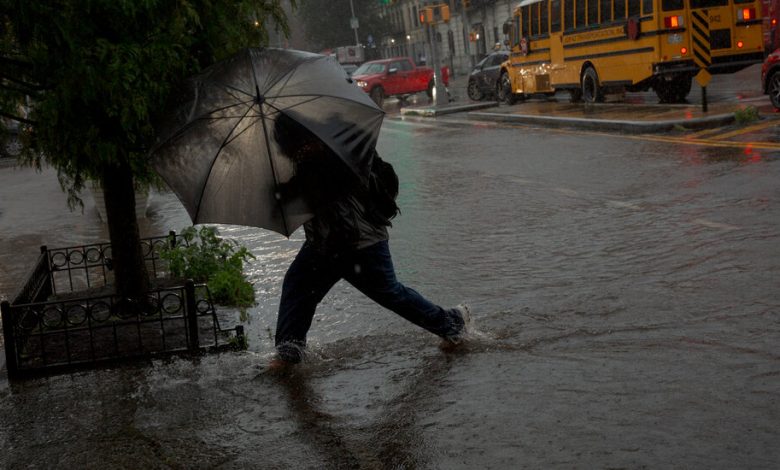A Mayor Goes AWOL in the Storm

On Friday, a flash flood washed over New York City, grinding the nation’s largest city to a halt and catching millions of people unaware.
Including, apparently, Eric Adams, the city’s mayor.
As the storm approached last week, Mr. Adams failed to adequately warn the public. Worse, the mayor seems to have suggested in the hours and days since that doing so was not his job.
“If anyone was caught off guard, they had to be living under a rock,” Mr. Adams said defensively during a radio interview with 1010 WINS Friday afternoon, as the stunned city was still drying out.
To help clear up any confusion, Mr. Adams: No one is blaming you for acts of God. But in a world shaped by climate change and inequality, preparing the city and its residents for increasingly frequent severe storms, disease outbreaks and air quality hazards is most definitely part of the job.
Mr. Adams could have held weather-related news conferences — as mayors have often done — to build awareness among city agencies and New York’s sizable press corps that a significant storm was on the way. He could have addressed the city by television or radio before the storm hit. He could have used his large bully pulpit to direct New Yorkers out of harm’s way.
As the effects of climate change worsen, Mr. Adams could use severe weather events like this one to galvanize New Yorkers around initiatives aimed at hardening the city’s defenses, like installing more bioswales, which use porous soil and plants to help divert storm waters away from pavement and sewage systems. Instead, the mayor opted out of all that work. Thursday evening, as the storm loomed, he attended a fund-raiser for his campaign.
The job of alerting the public was left to city agencies. “Urgent action may be needed to protect lives and property,” the city’s Department of Emergency Management warned at 6:55 a.m. Friday in a post on X, the social media site formerly known as Twitter. Americans shouldn’t have to be tuned into social media to receive critical public service announcements.
With residents unprepared, Friday was a day of unnecessary chaos and frustration. The city was lucky: No deaths have been reported from the storm, despite extremely hazardous conditions for millions of New Yorkers that could easily have turned deadly.
Buses with passengers on them flooded. Children, some traveling alone, made their way to school through rushing waters. Many basement apartments flooded — a hazard that the city is well aware of and that in other storms has led to deaths. So did some classrooms. Motorists had to be rescued by firefighters after stretches of the city’s major highways flooded and were temporarily transformed into rivers. At one point, half of the city’s subways were not running, partially suspended or snarled in long delays. Terminal A at La Guardia Airport flooded and was closed.
If more of the city’s commuters had known of the severity of the storm, some of them undoubtedly would have stayed home. On the 86th Street subway platform in Manhattan Friday afternoon, I saw a fistfight nearly break out as exhausted people jockeyed for precious space on packed trains. Outside a Starbucks coffee shop in Brooklyn, I watched good Samaritans frantically try to clear trash from a clogged drain, hoping to direct the filthy waters rising around their ankles into the city’s sewer system.
The first time the city heard directly from the mayor about the storm was midday Friday, when Mr. Adams assured the public that it was all going according to plan. “All the necessary precautions were taken,” Mr. Adams said in a news conference around noon, as many New Yorkers waded through knee-deep water.
He then praised the city’s emergency management commissioner, Zachary Iscol, as though it were the job of that little-known bureaucrat to communicate with 8 million New Yorkers.
Mr. Adams isn’t the first mayor to be caught flat-footed in a storm, or a crisis. Former Mayor Michael Bloomberg was pilloried for his response to a blizzard in December 2010 that deluged the 911 system. Part of the criticism was that Mr. Bloomberg was out of town, likely at his home in Bermuda. Sometimes, the consequences can be devastatingly steep. In 2020, Bill de Blasio, then the mayor, failed to alert the public as quickly or as urgently as he could have about the severity of Covid-19.
Like other mayors, Mr. Adams is also thin-skinned. That can be a dangerous trait when running a major U.S. city.
Mr. Adams doesn’t seem to be heeding the lessons from his predecessors’ costly mistakes. In June, toxic smoke from Canadian wildfires filled the city for 24 hours before Mr. Adams held a news conference to address the hazardous air quality. Staying on top of emergencies, remaining present during difficult times and directing the powerful (and expensive) levers of city government to serve the public is at the heart of the job. It can also be the difference between a well-run city and one that seemingly lurches from one crisis to the next.
It’s gotten harder to live in New York in the years since the pandemic, and the city’s mayors will have to do better. The housing crisis has metastasized. Severe weather is becoming more frequent and disruptive. The city is in the throes of an



